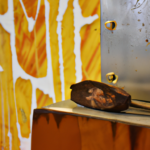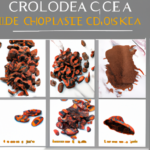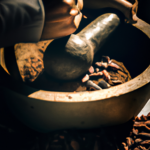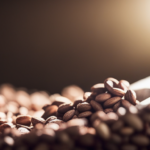Raw Food Ingredients
How To Make Raw Chocolate From Cacao Beans
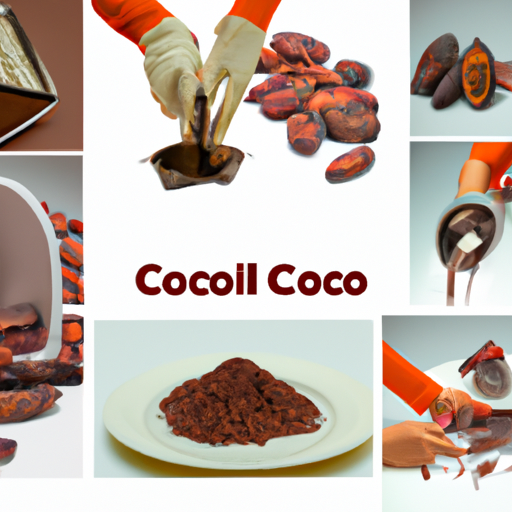
Picture enjoying a decadent, creamy square of chocolate that not only fulfills your cravings but also provides nourishment for your body. This is the wonder of raw chocolate sourced from cacao beans. Being a devoted chocolate enthusiast, I have explored the realm of creating homemade raw chocolate, and it has truly revolutionized my experience.
In this article, I will guide you through the step-by-step process of creating your own delectable raw chocolate from scratch. We’ll explore the health benefits of raw cacao, how to source and select high-quality cacao beans, and the art of roasting and grinding them to perfection.
I’ll also share techniques for adding sweetness and enhancing the flavor with delightful additions. We’ll dive into the intricacies of tempering and shaping your raw chocolate, and I’ll provide tips on storing and preserving your creations.
Lastly, we’ll explore a variety of mouthwatering raw chocolate recipes that will leave you craving for more. Get ready to embark on a journey of pure chocolate bliss, and embrace the raw chocolate lifestyle like never before.
Key Takeaways
- Raw chocolate made from cacao beans offers indulgence and nourishment, providing a nutrient-rich treat.
- Prioritize sustainable and ethical practices when sourcing cacao beans for raw chocolate production.
- Roasting techniques can enhance the natural sweetness and aroma of cacao beans, with different roasts offering unique flavors.
- Experiment with different sweeteners, flavor combinations, and mix-ins to create a variety of taste profiles for raw chocolate.
The Health Benefits of Raw Cacao
Now, let’s talk about why you should be excited about using raw cacao in your chocolate-making endeavors!
Raw cacao is not only delicious, but it also offers a range of health benefits that processed chocolate simply can’t match.
When it comes to nutrition, raw cacao is a powerhouse. It is packed with essential minerals like magnesium, iron, and zinc.
In fact, raw cacao has 40 times more antioxidants than blueberries! These antioxidants play a crucial role in protecting our cells from damage caused by harmful free radicals.
By incorporating raw cacao into your chocolate, you are not only satisfying your sweet tooth, but you are also providing your body with a nutrient-rich treat.
So, now that we understand the health benefits, let’s move on to sourcing and selecting quality cacao beans.
Sourcing and Selecting Quality Cacao Beans
First, you need to seek out the finest cacao beans available, like finding hidden gems in a treasure hunt. When sourcing cacao beans, it is important to prioritize sustainable farming practices and ethical sourcing. Look for beans that have been grown using organic methods, without the use of harmful chemicals or pesticides. Additionally, consider supporting farmers who employ fair trade practices, ensuring that they receive a fair wage for their hard work.
In your search for quality cacao beans, pay attention to the country of origin. Different regions produce cacao beans with unique flavor profiles, so experiment with beans from different countries to find your preference. When selecting beans, examine their appearance and aroma. Opt for beans that are uniform in color and have a rich, chocolatey scent. These indicators can help you identify beans of superior quality.
Transitioning into the subsequent section about roasting and grinding cacao beans, the sourcing and selection of high-quality cacao beans lays the foundation for creating delicious raw chocolate.
Roasting and Grinding Cacao Beans
To create a heavenly treat that will ignite your taste buds, you’ll want to dive into the art of roasting and grinding those exquisite cacao beans.
Roasting techniques play a crucial role in developing the complex flavors of raw chocolate. By carefully adjusting the temperature and duration, you can enhance the natural sweetness and aroma of the beans. Some prefer a light roast for a more delicate taste, while others opt for a deeper roast to bring out a richer, bolder flavor profile.
Once roasted, it’s time to grind the beans into a smooth, velvety consistency. Grinding methods vary, from using a traditional stone grinder to modern electric grinders. The goal is to transform the roasted beans into a fine paste, a process that releases the beans’ natural oils and creates the foundation for the luscious texture of your raw chocolate.
As we move into the next section about adding sweetness to your raw chocolate, the grinding process sets the stage for the perfect balance of flavors.
Adding Sweetness to Your Raw Chocolate
Enhance the delectable flavors of your homemade treat by infusing it with a touch of natural sweetness. When it comes to adding sweetness to your raw chocolate, there are various sweetener options to choose from.
Opting for natural sweeteners not only adds a delightful taste but also ensures a healthier indulgence. One popular choice is raw honey, which imparts a rich, floral sweetness. Alternatively, you can use maple syrup for a deep, caramel-like flavor. Another option is coconut sugar, which adds a subtle, earthy sweetness. If you prefer a zero-calorie sweetener, stevia is a great choice.
Experiment with different sweeteners to find your preferred taste profile. Once you’ve added the perfect amount of sweetness, you can move on to enhancing the flavor with additions that complement the chocolatey goodness.
Enhancing the Flavor with Additions
Once you’ve perfected the level of sweetness, it’s time to elevate the flavor of your homemade treat with a variety of delicious additions. Experimenting with different flavor combinations can take your raw chocolate to a whole new level.
Consider adding ingredients like sea salt, vanilla extract, or even a pinch of chili powder to create unique and exciting flavor profiles. You can also mix in dried fruits, nuts, or coconut flakes to add texture variations and a burst of flavor with every bite.
Don’t be afraid to get creative and think outside the box! As you explore different flavor options, you’ll discover endless possibilities for enhancing the taste of your raw chocolate.
Now that your chocolate is bursting with flavor, it’s time to move on to the next step of tempering and shaping your raw chocolate.
Tempering and Shaping Your Raw Chocolate
Now that we have enhanced the flavor of our raw chocolate with delicious additions, it’s time to move on to the next step: tempering and shaping.
Tempering is a crucial technique that ensures our chocolate has a shiny appearance and a firm, smooth texture. There are various tempering techniques to choose from, such as the seeding method or the tabling method, each requiring precision and patience.
Once our chocolate is properly tempered, we can proceed to shape it using molds. These molds come in a variety of shapes and sizes, allowing us to get creative with our chocolate creations. Whether it’s simple bars, elegant truffles, or intricate designs, the possibilities are endless.
Now that we have perfected our tempering and shaping skills, let’s move on to the next section on storing and preserving our raw chocolate, ensuring its freshness and quality for as long as possible.
Storing and Preserving Your Raw Chocolate
When it comes to storing and preserving my raw chocolate, I always make sure to use proper storage containers and maintain the right conditions. I find that airtight containers made of glass or BPA-free plastic work best, as they prevent moisture and odors from affecting the chocolate.
Additionally, I extend the shelf life of my raw chocolate by properly sealing them in the containers and storing them in a cool, dark place away from direct sunlight or heat sources.
Finally, to prevent blooming or melting, I recommend avoiding temperature fluctuations and keeping the chocolate away from strong odors, as they can affect its quality.
Proper storage containers and conditions
To keep your cacao beans fresh and preserve their flavor, store them in airtight containers with a cool temperature and low humidity. Proper storage is essential in ensuring the longevity of your raw chocolate.
When choosing storage containers, opt for those made of glass or metal that have a tight seal. This will prevent moisture and air from entering, which can cause the beans to spoil and their flavor to deteriorate.
Additionally, it is important to store the containers in a cool environment, away from direct sunlight and heat sources. Maintaining a low humidity level is crucial as high humidity can lead to the growth of mold and spoilage.
By following these proper storage and preserving conditions, you can extend the shelf life of your raw chocolate and enjoy its rich flavors for a longer period.
Transitioning into the subsequent section, let’s now explore how to extend the shelf life with proper sealing techniques.
Extending shelf life with proper sealing
By ensuring airtight containers with proper sealing, you can extend the shelf life of your cacao beans and preserve their rich flavor. Packaging techniques play a crucial role in preventing the deterioration of your raw chocolate. Here are some key points to consider:
- Vacuum sealing: Remove as much air as possible from the container to prevent oxidation and moisture absorption.
- Moisture-proof packaging: Use moisture-proof bags or containers to shield the cacao beans from humidity, which can cause mold growth.
- Light-blocking materials: Opt for opaque containers or bags that block out light, as exposure to light can degrade the quality of your beans.
- Temperature control: Store your cacao beans in a cool, dry place to slow down the aging process and maintain their freshness.
By implementing these packaging techniques, you can significantly prolong the shelf life of your cacao beans and ensure their optimal quality.
Now, let’s move on to some tips for preventing blooming or melting.
Tips for preventing blooming or melting
To prevent blooming or melting, here are some helpful tips:
- Keep your confections cool at all times.
- Store your raw chocolate in a cool, dry place, away from direct sunlight and strong odors.
- Use airtight containers to prevent moisture from getting in.
- Avoid exposing your chocolate to high temperatures.
- If you live in a warm climate, consider refrigerating or freezing your chocolate to extend its shelf life and maintain its quality.
Now that we’ve covered the importance of preventing blooming and melting, let’s move on to exploring raw chocolate recipes.
Exploring Raw Chocolate Recipes
In this discussion, I will explore the world of raw chocolate recipes and share some key points.
First, let’s talk about making raw chocolate bars or squares. This allows you to customize the flavors and textures to your liking, while still reaping the health benefits of raw cacao.
Next, we’ll delve into indulging in raw chocolate desserts and treats. These are a guilt-free way to satisfy your sweet tooth, with options ranging from rich chocolate mousse to decadent truffles.
Lastly, we’ll discuss enjoying raw chocolate drinks and smoothies. These offer a refreshing and nutritious way to incorporate raw cacao into your daily routine, providing a boost of antioxidants and energy.
Raw chocolate bars or squares
To create a delectable treat, why not whip up some mouthwatering raw chocolate bars or squares from scratch using cacao beans? Making your own raw chocolate bars allows you to have full control over the ingredients and create unique flavor combinations.
First, you’ll need raw chocolate molds, which come in various shapes and sizes. These molds allow you to create perfectly formed bars or squares that are visually appealing.
Next, comes the tempering process, which is crucial for achieving that shiny, smooth finish. Tempering involves heating and cooling the chocolate to specific temperatures to ensure the cocoa butter crystallizes correctly. This process gives your bars or squares a satisfying snap and prevents them from melting too quickly.
Now, with your perfectly tempered raw chocolate bars or squares, you can move on to creating an array of raw chocolate desserts and treats.
Raw chocolate desserts and treats
Crafting your own luscious confections from scratch using freshly ground cacao beans opens up a world of possibilities for tantalizing raw chocolate desserts and treats.
For beginners in the world of raw chocolate, there are simple recipes that can be enjoyed by both adults and kids alike. One popular treat is raw chocolate truffles, made by combining melted raw chocolate with dates, nuts, and a hint of vanilla. These bite-sized delights are perfect for satisfying your sweet tooth while still indulging in the health benefits of cacao.
Another favorite is raw chocolate avocado pudding, which blends creamy avocado with raw cacao powder and sweeteners like maple syrup or dates. The result is a silky smooth dessert that is both decadent and nutritious.
As we delve into the next section about raw chocolate drinks and smoothies, we can explore even more ways to incorporate this delectable ingredient into our daily lives.
Raw chocolate drinks and smoothies
Now that we’ve explored the realm of raw chocolate desserts and treats, let’s dive into the world of raw chocolate drinks and smoothies.
As a chocolate enthusiast, I can’t resist indulging in a velvety, rich raw chocolate smoothie. These smoothies are not only delicious, but they also offer numerous health benefits.
Incorporating raw chocolate into your smoothie recipes can provide a natural energy boost, thanks to its high content of antioxidants and minerals. Additionally, raw chocolate can enhance the flavor and creaminess of your smoothies, making them even more satisfying.
To create a tantalizing raw chocolate smoothie, consider blending raw cacao powder, almond milk, ripe bananas, and a touch of maple syrup. This combination creates a heavenly treat that will leave you feeling nourished and satisfied.
Now, let’s continue our journey by embracing the raw chocolate lifestyle and exploring its endless possibilities.
Embracing the Raw Chocolate Lifestyle
Incorporating raw chocolate into my healthy diet has been a game changer for me. It’s not only a delicious treat, but it’s also packed with antioxidants and other beneficial nutrients.
I love exploring other raw cacao recipes, like raw chocolate smoothies and energy balls, to keep my meals exciting and nutritious. Trying out new recipes and experimenting with different flavors is a fun and creative way to embrace the raw chocolate lifestyle.
Sharing my raw chocolate creations with others brings me so much joy and satisfaction. There’s something special about seeing their faces light up with delight as they taste the rich and decadent flavors. It’s a wonderful feeling to be able to share something I’m passionate about and to spread the joy of raw chocolate to others.
Incorporating raw chocolate into a healthy diet
To truly savor the rich and indulgent flavors of raw chocolate, there’s no better way to nourish your body than by seamlessly blending it into a wholesome, balanced diet.
Raw chocolate can be incorporated in various ways, adding depth and complexity to your favorite recipes. Whether it’s in baking or cooking, raw chocolate can elevate the flavors of both sweet and savory dishes.
In baking, you can use raw chocolate as a substitute for conventional cocoa powder, creating decadent treats that are not only delicious but also packed with nutrients.
When it comes to savory dishes, adding a touch of raw chocolate to sauces or stews can bring a delightful richness and depth of flavor.
By incorporating raw chocolate into your diet, you can experience its health benefits while enjoying its incredible taste.
Now, let’s explore other raw cacao recipes and discover the versatility of this incredible ingredient.
Exploring other raw cacao recipes
Let’s dive into some delicious recipes that showcase the versatility of raw cacao! Raw cacao isn’t just limited to sweet treats; it can also be incorporated into savory dishes, resulting in unique flavor combinations that are sure to impress your taste buds.
Here are three mouthwatering recipes to try:
-
Raw Cacao Rubbed Steak: Coat a juicy steak with a mixture of raw cacao powder, sea salt, and spices for a rich and smoky flavor profile.
-
Raw Cacao Chili: Add a tablespoon of raw cacao powder to your favorite chili recipe for a subtle richness and depth of flavor.
-
Raw Cacao Mole Sauce: Create a velvety mole sauce by blending raw cacao powder with dried chilies, garlic, spices, and other ingredients. Drizzle it over grilled chicken or roasted vegetables for a decadent twist.
These savory recipes will elevate your culinary skills and introduce you to the incredible world of incorporating raw cacao into unexpected dishes.
Now, let’s move on to sharing your raw chocolate creations with others.
Sharing your raw chocolate creations with others
Impress your loved ones by sharing the irresistible delights you’ve crafted using the delectable essence of raw cacao.
When it comes to sharing your raw chocolate creations, there are a few tips that can make the experience even more enjoyable for both you and your recipients.
First, consider packaging your raw chocolate treats in beautiful, eco-friendly gift boxes or jars. This will not only make them look more appealing, but also protect them during transportation.
Another idea is to create personalized labels or tags with a heartfelt message, adding a special touch to your gift.
Additionally, you can include a small recipe card with suggestions on how to enjoy the raw chocolate, such as adding it to smoothies or using it as a topping for desserts.
Sharing your raw chocolate creations is a wonderful way to spread joy and introduce others to the amazing world of cacao.
Frequently Asked Questions
Can I use any type of cacao beans for making raw chocolate?
Yes, you can use any type of cacao beans for making raw chocolate. However, for the best results, it’s important to source high-quality cacao beans. Look for beans that are organic, fair trade, and have a high percentage of cacao content.
How long does it take to roast and grind cacao beans?
Roasting time for cacao beans depends on the desired flavor profile, typically ranging from 20 to 30 minutes. Grinding time varies based on equipment and desired consistency, but can take anywhere from 30 minutes to an hour.
What are some natural sweeteners I can use in my raw chocolate?
There are so many amazing natural sweeteners you can use in your raw chocolate, it’s like a sweet explosion! Some great alternatives include maple syrup, coconut sugar, agave nectar, and dates. These options will add a delicious sweetness to your homemade chocolate.
Are there any specific ingredients I can add to enhance the flavor of my raw chocolate?
To enhance the flavor of raw chocolate, I suggest trying unique flavor combinations like adding a hint of sea salt or a touch of vanilla extract. You can also experiment with spices like cinnamon or chili powder for a delightful twist.
Can I use any type of mold to shape my raw chocolate?
From silicone to metal, there are various molds available for shaping raw chocolate. To achieve a smooth finish, it’s crucial to properly temper the chocolate by heating and cooling it in a specific manner.
Can I Use Cacao Nibs Instead of Cacao Beans to Make Raw Chocolate?
Yes, you can absolutely use cacao nibs when making raw chocolate. In fact, using cacao nibs instead of cacao beans is a common practice, as the nibs are already partially ground and ready to be used in chocolate making. Simply grind them down further to achieve the desired texture.
Conclusion
In conclusion, making raw chocolate from cacao beans is a truly fascinating process.
First, it starts with sourcing and selecting the best cacao beans.
Next, the beans are roasted to bring out their rich flavors and then ground to perfection.
To enhance the taste, sweetness and flavor can be added with carefully chosen additions.
Proper tempering and shaping techniques are important for creating a beautiful and professional-looking final product.
So why wait? Dive into the world of raw chocolate and explore the endless possibilities it offers.
Your taste buds will thank you.
Rachael, the Editor in Chief of RachaelsRawFood.com, is an inspiring and passionate individual who has dedicated her life to promoting the benefits of a raw food lifestyle. Known for her vibrant and energetic personality, Rachael has built a strong online presence that has transformed her personal journey into a thriving community of raw food enthusiasts.
Raw Food Ingredients
How Much Caffeine in Cocoa?
Not all cocoa products are created equal when it comes to caffeine content – discover which one might surprise you!

When evaluating the caffeine levels in cocoa, it’s important to recognize that dark chocolate contains around 43 mg of caffeine per 100 grams due to its high cocoa solid content. Dark chocolate has a higher caffeine content compared to milk or white chocolate. This means that consuming dark chocolate in moderation can assist in managing your caffeine intake. On the other hand, milk chocolate has around 20 mg of caffeine per 100 grams while white chocolate is caffeine-free. Cocoa powder, commonly used in baking and beverages, contains a substantial 230 mg of caffeine per 100 grams. Being aware of these distinctions in chocolates can help you make informed decisions about your caffeine consumption.
Key Takeaways
- Caffeine content in cocoa varies based on cocoa solid concentrations.
- Unsweetened cocoa powder can contain around 230 mg of caffeine per 100 grams.
- Roasting cocoa solids influences the final caffeine content in cocoa products.
- Dark chocolate, with high cocoa solid content, has more caffeine than milk chocolate.
- Moderate consumption of cocoa products helps manage caffeine intake.
Caffeine Content in Dark Chocolate
Dark chocolate boasts a caffeine content of approximately 43 mg per 100 grams, mainly deriving from its higher cocoa solid composition. When we indulge in this decadent treat, we aren't only savoring its rich cocoa flavor but also a subtle caffeine kick. Compared to milk or white chocolate, dark chocolate contains a higher amount of caffeine.
Please bear in mind that moderate consumption of dark chocolate can assist individuals in managing their caffeine intake effectively. The caffeine levels in dark chocolate are about one-fourth of what you'd find in a standard cup of coffee. So, if you're looking for a milder caffeine boost, a piece of dark chocolate might just do the trick without the jitters that sometimes accompany a strong cup of coffee.
Enjoy your dark chocolate in moderation, savoring both its taste and the gentle pick-me-up it provides.
Caffeine Levels in Milk Chocolate

Milk chocolate, known for its creamy texture and sweet flavor, contains a modest caffeine content of approximately 5.6 mg per ounce, as indicated by USDA data. Unlike dark chocolate, milk chocolate has a lighter color due to lower cocoa content, resulting in reduced caffeine levels.
The delightful creamy taste in milk chocolate comes from a harmonious blend of cocoa and milk powder. While dark chocolate boasts higher caffeine content, milk chocolate remains a popular choice for those seeking a sweet treat with minimal caffeine intake.
Caffeine Presence in White Chocolate
With its unique composition excluding cocoa solids, white chocolate stands out as a caffeine-free alternative to its darker counterparts. White chocolate is crafted from a blend of cocoa butter, milk powder, sugar, and vanilla, making it a delectable treat without the stimulating effects of caffeine. For individuals sensitive to caffeine, white chocolate offers a creamy texture and indulgent flavor without the worry of unwanted side effects. This makes it a popular choice for desserts among those looking to steer clear of caffeine in their sweet treats.
Compared to dark chocolate, which contains cocoa solids and hence caffeine, white chocolate provides a caffeine-free option for those seeking a more mellow indulgence. So, if you're in the mood for a luscious and smooth chocolate experience without the buzz of caffeine, white chocolate is the perfect choice for your next dessert delight.
Impact of Cocoa Solids on Caffeine

In determining the caffeine levels in cocoa products, the percentage of cocoa solids plays a significant role. Here are some key points about the impact of cocoa solids on caffeine content:
- Caffeine Derivation: The caffeine content in cocoa primarily comes from cocoa solids, making it an important factor in determining the overall caffeine levels in cocoa-based products.
- Dark Chocolate: Dark chocolate, known for its higher cocoa solid content, tends to contain more caffeine compared to milk or white chocolate varieties due to this higher concentration.
- Unsweetened Cocoa Powder: A 100g serving of unsweetened cocoa powder can contain around 230mg of caffeine, reflecting the impact of the high cocoa solid content in this form.
- Health Benefits: The roasting process of cocoa solids not only affects the flavor profile but also influences the caffeine content, contributing to the potential health benefits associated with consuming cocoa products like hot cocoa.
Comparing Caffeine in Different Chocolates
Comparing the caffeine content in different chocolates reveals varying levels based on their cocoa solid concentrations. Dark chocolate contains about 43 mg of caffeine per 100 grams, making it a stronger caffeinated option compared to milk chocolate, which only has around 20 mg per 100 grams.
Surprisingly, white chocolate, derived from cocoa butter, doesn't contain any caffeine at all. For those seeking a more potent caffeine kick, cocoa powder is the way to go, boasting a high concentration of 230 mg per 100 grams.
The amount of caffeine in chocolate products is closely linked to the cocoa solid content, with dark chocolate containing the highest levels. So, the next time you're craving a chocolate treat but also need a little energy boost, opt for dark chocolate to get the most caffeine per bite.
Frequently Asked Questions
Is There More Caffeine in Cocoa Than Coffee?
There's more caffeine in cocoa than in coffee. Cocoa powder packs 230 mg per 100 grams, surpassing most coffee varieties. Dark chocolate has even more caffeine due to higher cocoa content. It's a rich, unique energy source.
Is There a Lot of Caffeine in Hot Cocoa?
There isn't a lot of caffeine in hot cocoa. It depends on the brand and recipe. Starbucks hot chocolate has around 25 mg per serving, while basic mixes have about 5 mg. The amount of cocoa powder used influences the caffeine content.
Is There Caffeine in Hershey's Cocoa?
Absolutely, Hershey's Cocoa does contain caffeine, but it's not overwhelming. It adds a delightful hint of energy in each spoonful. Perfect for baking or a cozy cup of hot chocolate. Just the right amount!
Is Cocoa a Stimulant Like Caffeine?
Cocoa stimulates like caffeine due to its theobromine content. Decaf versions offer a solution for caffeine-sensitive folks. Options include regular cocoa with caffeine, Dutch-processed cocoa with less, and decaf cocoa with reduced caffeine while keeping healthful compounds.
What are the potential health effects of consuming high levels of caffeine in cocoa?
Unveiling cocoa caffeine levels can lead to potential health effects of excessive consumption. High levels of caffeine in cocoa may contribute to insomnia, nervousness, and fast heartbeat. It can also cause gastrointestinal discomfort and exacerbate anxiety disorders. Moderation in consuming caffeinated cocoa products is recommended for overall health.
Conclusion
To sum up, the caffeine content in cocoa varies depending on the type of chocolate. Dark chocolate typically has the highest caffeine levels, followed by milk chocolate and white chocolate. The amount of cocoa solids in the chocolate also affects the caffeine content.
Remember, just like different chocolates have different levels of caffeine, we all have unique strengths and abilities. Embrace your individuality and always aim for balance in everything you do.
Rachael, the Editor in Chief of RachaelsRawFood.com, is an inspiring and passionate individual who has dedicated her life to promoting the benefits of a raw food lifestyle. Known for her vibrant and energetic personality, Rachael has built a strong online presence that has transformed her personal journey into a thriving community of raw food enthusiasts.
Raw Food Ingredients
5 Key Differences: Caffeine Content in Cocoa Vs Coffee
Open the door to understanding the contrasting caffeine levels in cocoa and coffee, revealing surprising insights that will reshape your beverage choices.

When comparing the caffeine levels in cocoa and coffee, it is important to understand that cocoa generally has lower caffeine content than coffee. Dark chocolate contains approximately 12 milligrams of caffeine per ounce, while hot cocoa typically ranges from 5 to 10 milligrams per ounce. In contrast, brewed coffee can have significantly higher levels, varying from 95 to 165 milligrams per 8-ounce cup.
Cocoa is considered a milder option for individuals aiming to limit their caffeine intake, with theobromine providing a gradual energy increase. Meanwhile, coffee's caffeine content offers immediate alertness, and understanding these distinctions can help you select based on your preferred effects.
Key Takeaways
- Cocoa contains lower caffeine levels but compensates with theobromine for a gradual energy increase.
- Coffee has higher caffeine content, offering an immediate alertness boost and potentially higher metabolic rate.
- Theobromine in cocoa promotes relaxation, while caffeine in coffee provides intense alertness and mood fluctuations.
- Hot chocolate is a good option for reducing caffeine intake while still benefiting from theobromine effects.
- Understanding caffeine variances helps make informed choices for desired energy levels and mood effects.
Caffeine Levels in Cocoa Vs Coffee
When comparing caffeine levels in cocoa versus coffee, it's evident that cocoa generally contains lower amounts per serving. Dark chocolate, made from cacao beans, contains around 12 milligrams of caffeine per ounce, while a 1-ounce serving of hot cocoa mix typically has 5-10 milligrams. Even a 16-ounce serving of Starbucks hot chocolate only contains about 25 milligrams of caffeine.
On the other hand, coffee, when brewed, can range from 95 to 165 milligrams of caffeine per 8-ounce cup, depending on the type and brewing method. This significant difference in caffeine content between cocoa and coffee makes cocoa a milder option for those looking to limit their caffeine intake.
Impact on Alertness and Energy

Typically, the immediate alertness and energy boost from caffeine in coffee can last for hours. This surge in alertness is due to caffeine's stimulating effect on the central nervous system. On the other hand, cocoa contains theobromine, which provides a more gradual increase in energy levels. Unlike caffeine, theobromine doesn't cause sudden spikes and crashes, offering a smoother energy curve.
Coffee's caffeine content can temporarily boost the metabolic rate, potentially supporting weight management efforts. This increased metabolic rate can aid in burning calories and may contribute to weight loss when combined with a balanced diet and regular exercise. Additionally, theobromine in cocoa contributes to the thermogenic effect, leading to mild calorie burning in the body.
Both caffeine and theobromine can influence mood. Caffeine tends to provide a more intense and quick-acting mood elevation, while theobromine promotes feelings of relaxation and contentment. Understanding the differences in alertness, energy, metabolic effects, and mood enhancements between cocoa and coffee can help individuals make informed choices based on their preferences and wellness goals.
Metabolic Variances and Effects
Regarding metabolic variances and effects, the varying caffeine levels between cocoa and coffee play a significant role. When comparing the metabolic impact of caffeine in cocoa and coffee, it is crucial to note that cocoa contains lower levels of caffeine but compensates with theobromine, which aids in the thermogenic effect, promoting calorie burning and metabolic activity. On the other hand, coffee, especially brewed varieties, contains higher levels of caffeine, potentially providing a temporary boost to the metabolic rate, which could assist in weight management. While caffeine in coffee offers a quick energy surge, theobromine in cocoa leads to a more gradual rise in energy levels, avoiding sudden spikes and crashes. To summarize the metabolic differences, I've created a table below:
| Aspect | Cocoa | Coffee |
|---|---|---|
| Caffeine Content | Lower levels | Higher levels |
| Additional Component | Theobromine | Caffeine |
| Metabolic Impact | Thermogenic effect | Temporary metabolic rate boost |
| Energy Levels | Gradual rise | Quick surge |
| Weight Management | Aids in calorie burning | Potential assistance |
Mood Enhancement Disparities

In comparing the mood enhancement effects of theobromine in cocoa and caffeine in coffee, notable disparities emerge in their impact on mental well-being.
The theobromine found in cocoa promotes relaxation and contentment, offering a gradual rise in energy levels that leads to a gentle and long-lasting mood enhancement experience.
On the other hand, caffeine delivers an intense and fast-acting boost in alertness, providing immediate energy levels that can lead to abrupt spikes and crashes.
While both theobromine and caffeine uplift mood, theobromine's effects are characterized by a steady and gradual increase in energy levels, creating a sense of calm and contentment.
In contrast, caffeine's impact is more intense and temporary, resulting in rapid alertness but also the potential for fluctuations in mood. Understanding these differences can help individuals choose between cocoa and coffee based on their desired mood enhancement effects.
Health Implications and Considerations
Health implications and considerations surrounding caffeine consumption warrant close attention due to its potential impact on various aspects of well-being. When comparing a cup of coffee to hot chocolate, it's vital to note the amount of caffeine present.
While coffee contains much caffeine, hot chocolate has less caffeine but isn't entirely devoid of it. The main active ingredients in hot chocolate are theobromine and caffeine, where theobromine is a relative of caffeine and also has stimulant effects, although milder. If you're looking to reduce your caffeine intake, opting for hot chocolate over a cup of coffee can be a good choice.
Being mindful of the caffeine content in chocolate products is important, especially if you're sensitive to caffeine or belong to vulnerable populations like children or pregnant women. Understanding the caffeine levels in different beverages allows you to make informed decisions about your consumption for better overall health.
Frequently Asked Questions
Is There Caffeine in Coffee Vs Cacao Powder?
Yes, there is caffeine in coffee, with around 140 milligrams in a 12-ounce cup. On the other hand, cacao powder contains only about 12 milligrams per tablespoon, making it a great caffeine-free alternative for those seeking a milder boost.
What Is the Difference Between Cocoa and Coffee?
When comparing cocoa and coffee, cocoa offers a rich, chocolatey flavor and is packed with antioxidants and minerals. Coffee, on the other hand, provides a robust, bitter taste and a jolt of caffeine for that morning pick-me-up.
Why Is Cocoa Better Than Coffee?
I believe cocoa is superior to coffee because it offers a gentler energy boost, promotes relaxation and contentment, and provides sustained vitality without sudden crashes. Plus, dark chocolate's theobromine supports cellular health and tastes delicious.
How Much Caffeine Is in Cocoa Powder Vs Decaf Coffee?
In cocoa powder vs decaf coffee, cocoa has 12-26mg of caffeine per tbsp, while decaf coffee holds 2-5mg per 8-ounce cup. The choice hinges on desired caffeine levels and flavor. I prefer cocoa's lower caffeine content.
How does the caffeine content in hot chocolate compare to coffee?
Hot chocolate caffeine content is significantly lower than that of coffee. While an 8-ounce cup of hot chocolate contains about 5-10 milligrams of caffeine, the same size of coffee can have anywhere from 95-200 milligrams. It’s a notable difference for those looking to limit their caffeine intake.
Conclusion
To sum up, while cocoa and coffee both contain caffeine, the levels vary significantly. Cocoa generally has lower caffeine content compared to coffee, impacting alertness, energy levels, and mood enhancement differently.
It's crucial to keep these differences in mind when choosing between the two beverages for your daily consumption. Remember, moderation is key to maintaining a healthy balance in your caffeine intake.
So, whether you prefer a cup of cocoa or a mug of coffee, enjoy it in moderation for the best benefits!
Rachael, the Editor in Chief of RachaelsRawFood.com, is an inspiring and passionate individual who has dedicated her life to promoting the benefits of a raw food lifestyle. Known for her vibrant and energetic personality, Rachael has built a strong online presence that has transformed her personal journey into a thriving community of raw food enthusiasts.
Raw Food Ingredients
A Guide to Becoming a Good King
Kingship demands wisdom, fairness, integrity, courage, and humility – essential traits for a successful reign and prosperous kingdom." Keep reading to uncover the secrets of becoming a good king.

In order to be a good king, one must embody wisdom, fairness, integrity, courage, and humility to lead the kingdom with honor. Wisdom is essential for making important decisions, fairness ensures just treatment for all, integrity builds trust and respect, courage is crucial for facing challenges, and humility reminds us of our humanity. Historical kings such as Solomon, Arthur, David, Charlemagne, and Ramses II serve as role models for these leadership traits.
As a king, embracing challenges, understanding the world, seeking personal growth, and learning from the past are essential responsibilities. Developing leadership skills, making wise decisions, and prioritizing the well-being of the people are key to effective kingship. Every step on the path to becoming a good king is critical for a successful reign and prosperous kingdom.
Key Takeaways
- Embrace wisdom for informed decisions.
- Practice fairness for just treatment.
- Uphold integrity to earn trust.
- Show courage in facing challenges.
- Maintain humility for empathy and respect.
Qualities of a Good King
Being a good king requires embodying qualities such as wisdom, fairness, integrity, courage, humility, and compassion in decision-making and leadership. Power comes with responsibility, and as a king, it's essential to wield this power wisely. Wisdom is vital in making sound judgments that benefit the kingdom as a whole. Fairness guarantees that all subjects are treated justly and equitably, fostering a harmonious society. Integrity is the foundation of trust and respect, key elements in effective leadership.
Courage is necessary to face challenges and make difficult decisions, even when met with opposition. Humility reminds a king of his humanity and the importance of humility in interactions with all subjects. Compassion demonstrates a king's care and empathy towards his people, fostering a sense of unity and loyalty. Effective communication is crucial for conveying decisions, listening to concerns, and inspiring confidence in leadership.
Historical Kings as Role Models

King Solomon, renowned for his wisdom and leadership, stands as an exemplar among historical kings who serve as role models for future leaders. Looking at figures like King Arthur, known for his justice and valor in medieval legends, and King David, celebrated for his faith and courage in battle, we find lessons that transcend time. Charlemagne's legacy of military conquests and cultural revival, alongside Ramses II's grand building projects and military campaigns, offer diverse insights into effective kingship. Below is a table summarizing key attributes of these historical kings:
| King | Attributes |
|---|---|
| King Solomon | Wisdom, leadership |
| King Arthur | Justice, valor |
| King David | Faith, courage |
| Charlemagne | Military prowess, culture revival |
| Ramses II | Building projects, military campaigns |
Studying these historical figures can provide valuable lessons on the multifaceted qualities that make a great ruler.
Responsibilities of Kingship
Embracing challenges and living authentically are central to fulfilling the responsibilities inherent in kingship. As men aspiring to be good kings, it's essential for us to understand that the world requires leaders who are kind, humble, and committed to personal growth.
The journey to becoming a good king involves more than just wielding power and responsibility—it entails sacrificing comfort for growth and transformation. Seeking the ancient path of masculinity, as exemplified by figures like Morgan, teaches us the importance of humility, vulnerability, and character development.
In fulfilling the responsibilities of kingship, we're entrusted with power not for our own gain, but for the betterment of the world around us. Just as seeds need Good Soil to flourish, we must nurture our own growth to lead effectively.
Leadership Skills for Kings

Developing essential leadership skills is crucial for aspiring kings seeking to fulfill their responsibilities with humility, vulnerability, and a focus on character development. As you study the world around us, the power and responsibility of what kingship entails become clearer. Here are some key points to think about on your path to becoming a king:
- Embrace challenges and live authentically.
- Seek ancient paths of masculinity for guidance.
- Reflect on your identity, purpose, and ability to be entrusted with power for good.
- Sacrifice comfort for growth, transformation, and participation in universal creativity.
The journey of becoming a king isn't just about gaining authority but about understanding the remarkable fellowship of like-hearted individuals who share similar goals. Engage in group discussion questions, consider between-session personal study, and explore the depths of your masculine soul. This is the path to restoring what it means to be a true king.
Importance of Wise Decision-Making
Steering through the intricacies of leadership, especially in the domain of kingship, requires a sharp focus on the art of prudent decision-making. Wise decision-making is like the compass guiding the ship of leadership towards success.
Good kings understand that their choices impact not just themselves but also the lives of those they rule over. They prioritize the well-being of their people over personal gains, embodying the essence of true leadership.
Seeking counsel from trusted advisors and reflecting on core values are essential practices in the domain of wise decision-making. By embracing humility and self-awareness, kings can navigate the complex web of choices with clarity and integrity.
Just like a six-session video Bible study can guide individuals in restoring the heart, wise decision-making is essential for becoming the kind of leaders our world needs. Let's start on this journey of radical reconstruction, where every decision is a step towards being counted among the good kings of history.
Frequently Asked Questions
What Is the Becoming a King Guide?
The Becoming a King guide is a transformative resource created by Morgan Snyder to help men grow into responsible kings. It offers practical tools and profound insights to aid personal development and transformation.
What Are the Qualities of a Good King?
Being a good king means embodying humility, wisdom, and integrity. Prioritizing the well-being of my people, making decisions for the greater good, and showing courage, justice, and compassion in all actions. Seeking counsel and valuing diverse perspectives is essential.
What Makes a True King?
Beneath the crown lies a heart that beats with humility and a spirit that soars with honor. True kings are forged in the fires of challenge, embracing authenticity and growth to inspire others.
What Makes a Real King?
Being a true king means embodying humility, courage, and empathy. It's about serving others and leading with integrity. I endeavor to cultivate these qualities daily, embracing challenges and seeking growth in all aspects of my life.
How Can Sacred Cacao be Incorporated Into Kingship Rituals?
In kingship rituals, the sacred cacao ritual holds great significance. The ceremonial drinking of cacao symbolizes the divine connection between the ruler and the spiritual realm. It is believed to impart wisdom and strength, making it a crucial element in the coronation and leadership rites of many cultures.
Conclusion
To sum up, becoming a good king requires a combination of qualities, skills, and responsibilities. Remember, 'With great power comes great responsibility.'
By studying historical kings as role models, practicing leadership skills, and making wise decisions, one can aspire to be a just and effective ruler.
It's a challenging path, but with dedication and perseverance, anyone can endeavor to be a worthy leader for their kingdom.
Rachael, the Editor in Chief of RachaelsRawFood.com, is an inspiring and passionate individual who has dedicated her life to promoting the benefits of a raw food lifestyle. Known for her vibrant and energetic personality, Rachael has built a strong online presence that has transformed her personal journey into a thriving community of raw food enthusiasts.
-

 Health and Wellness2 months ago
Health and Wellness2 months agoDoes Eating Raw Food Help You Lose Weight? Discover the Truth
-

 Kitchen Essentials for Raw Food Preparation1 month ago
Kitchen Essentials for Raw Food Preparation1 month agoCan You Cook Raw Food in an Air Fryer? Discover the Possibilities
-

 Raw Food Recipes2 months ago
Raw Food Recipes2 months agoHow Much Raw Food to Feed Your Puppy: Essential Tips
-

 Raw Food Recipes2 months ago
Raw Food Recipes2 months agoHow to Defrost Dog Raw Food Properly
-

 Health and Wellness2 months ago
Health and Wellness2 months agoHow Long Does It Take Bacteria to Spread From Raw Food? Essential Info
-
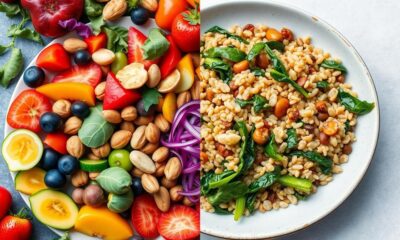
 Raw Food Recipes2 months ago
Raw Food Recipes2 months agoRaw Food Vs. Vegan: Which Diet Is Better?
-
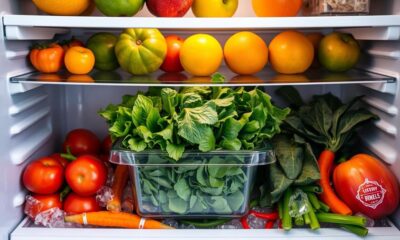
 Kitchen Essentials for Raw Food Preparation1 month ago
Kitchen Essentials for Raw Food Preparation1 month agoWhich Raw Food Should Be Stored Above? Essential Tips
-

 Raw Food Recipes2 months ago
Raw Food Recipes2 months agoIs Raw Food Good for Cats? Find Out Here



